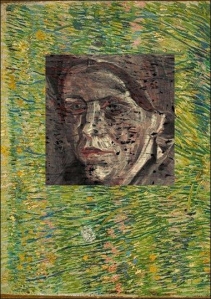
Check out the cool Van Gogh picture to the left. Using high intensity X-Rays, Scientists discovered the face over which Van Gogh painted Patch of Grass. Cool. Even cooler is, unlike scientists at Delft University, you’re the one adding the layers and your readers get to uncover them.
I’m a little over a third of the way through the second draft of my novel and it reminds me of creating amazing textures in Photoshop. Like Photoshop, the writer begins with pretty ordinary stuff: A story, some words, some images floating around our imagination. By themselves they don’t amount to much. Heck, even your story is a collection of bits of stories that have already been told.
Good thing it’s the telling that sets your story apart.
My first draft, which I recounted here, left much to be desired. Through the first third of my second draft, I am focusing on getting the story down – tighter story arc, fewer characters, plausible motivations. I’m looking to write something that I can build on during my next round of revisions. And you can be sure there will be more revision.
So far, I’m please with the results. As I write, I’m conscious that my prose is pretty bare at this point, but that’s okay because I’ll be teasing out the tone and moods I want to create, as well as character story arcs and the characters themselves. Carol Benedict over at The Writing Place blog offers this perspective on using revisions to add layers to your story:
Adding layers to the basic story serves several purposes:
1. Characters can be fleshed out so they become more realistic.
2. Foreshadowing can be inserted to give the reader clues about what lies ahead, so when events occur they make sense and seem believable.
3. Relationships can be strengthened or clarified so they are easier to understand.
4. Descriptions and sensory details can be expanded to make the setting more authentic.
5. Word choices can be refined to elicit the desired tone, and make the dialog more realistic.
Having a solid foundation to build upon is crucial, but adding in layers of subplots, exposition, and specific details can transform a basic plot into a complex, unique story.
The endgame is to provide a richness to my writing that not only compels the reader to turn the pages, but also resonates with said reader after the book has been put back on the shelf – or better yet – passed along to the reader’s friend with whom they want to share the experience.
Part of the effect of layering can result in what Donald Maas calls bigness over at Writer Unboxed. As he puts it at the end of the post:
Crafting a big novel is a big commitment. But then, who wants to write small?
Thanks for sharing these thoughts and these links. Very helpful.
Glad to be of some help. Thanks for stopping by!
Pingback: Tweets that mention Layers and Texture – Revising Your Writing « Words and Coffee -- Topsy.com
Jonathan, thanks for mentioning my post on revisions. I’m glad it was helpful.
I like your writing style. I’m adding your blog to my Blogs I Like page, and will be back to read more of your posts.
Carol
Carol, you are so welcome. Your post articulated what I’m coming to realize as I revise. Knowing that I don’t have to get it right in the first, second or even third draft takes pressure off and allows me to enjoy the process. I’ll be visiting over your way more to check out your other posts. Thanks for commenting!